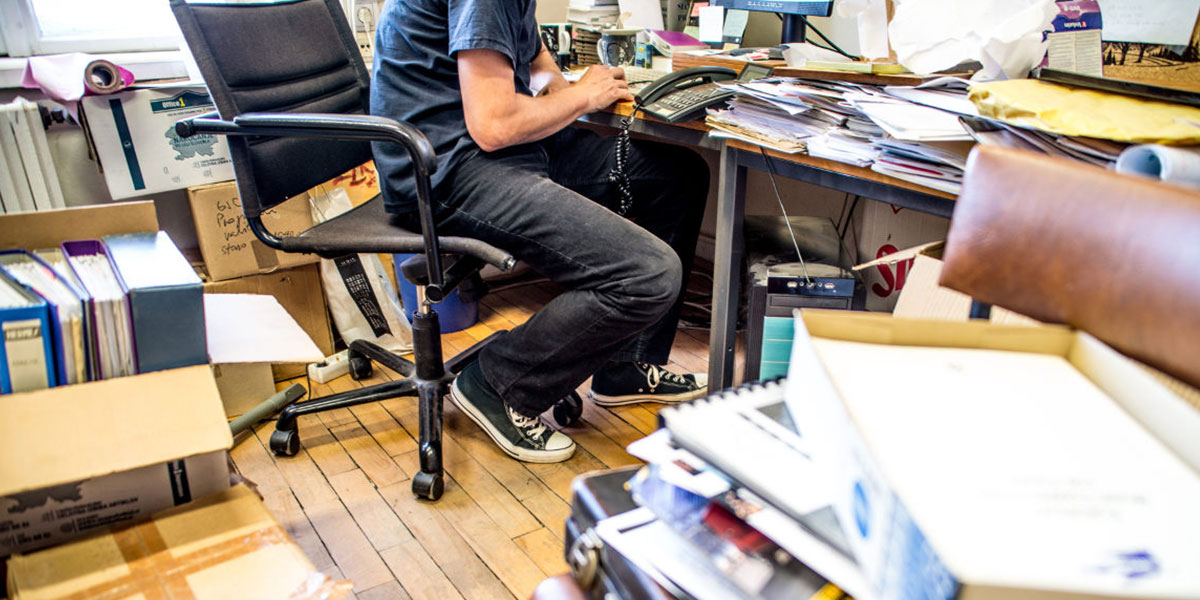
Table of Contents
ToggleImpact of a Cluttered Workspace on Productivity and Well-being
Mental Clutter:
When your workspace is cluttered, it can lead to mental clutter. This means your mind feels overwhelmed and distracted by the mess around you.
Time Management:
A disorganized workspace can make it harder to find things quickly, wasting time searching for items you need. This can disrupt your time management and make you less efficient.
Benefits of a Well-Organized Workspace
Workflow Efficiency:
With a well-organized workspace, you can streamline your workflow. Everything has its place, making tasks easier to complete efficiently.
Mental Clarity:
A tidy workspace promotes mental clarity. You can think more clearly and focus better when you're not surrounded by chaos.
Improved Time Management:
When everything is organized, you can manage your time more effectively. You spend less time searching for things and more time being productive.
Reduced Stress:
A clutter-free workspace can reduce stress levels. You feel calmer and more in control when your environment is neat and organized.
Below we will discuss 5 Steps to a Productive Workspace.

Step 1: Declutter and Conquer: Organizing Your Space for Productivity
The Benefits of Decluttering
In today's fast-paced world, it's easy for our physical and digital spaces to become cluttered and overwhelming. However, did you know that decluttering can have a significant impact on your productivity and overall well-being? By creating a clean and organized environment, you can reduce stress, increase focus, and boost your efficiency.
Decluttering is closely related to the concepts of digital detox and minimalism. A digital detox involves taking a break from technology and electronic devices, allowing you to recharge and refocus. Minimalism, on the other hand, is a lifestyle choice that emphasizes living with fewer possessions and focusing on what truly matters.
Organizing Your Physical Workspace
Your physical workspace is where you spend a significant portion of your day, so it's essential to keep it organized and clutter-free. Here are some actionable tips to help you declutter your desk and office:
- Invest in a good filing system to keep important documents and papers organized.
- Use desk organizers, such as trays, drawers, and pen holders, to keep your desk tidy and accessible.
- Regularly go through your desk drawers and cabinets, removing any items you no longer need.
- Consider adopting a minimalist approach by only keeping essential items on your desk and storing the rest in designated areas.
Organizing Your Digital Files and Emails
In addition to your physical workspace, it's crucial to maintain a well-organized digital environment. Here are some tips for decluttering your digital files and emails:
- Create a consistent file naming system and folder structure to keep your digital files easily accessible.
- Regularly backup your important files to an external hard drive or cloud storage service.
- Unsubscribe from unnecessary email newsletters and mailing lists to reduce inbox clutter.
- Use email filters and rules to automatically sort incoming messages into relevant folders.
Resources and Tools for Decluttering
If you're looking for additional guidance and support in your decluttering journey, there are many resources and tools available. Consider reading books on minimalism and decluttering, such as "The Life-Changing Magic of Tidying Up" by Marie Kondo or "Decluttering at the Speed of Life" by Dana K. White. You can also find numerous online articles, podcasts, and videos that offer practical tips and inspiration for creating a clutter-free life.
Decluttering your physical and digital spaces can have a profound impact on your productivity, focus, and overall well-being. By implementing simple organizational strategies and embracing a minimalist mindset, you can create a more efficient and stress-free environment that supports your personal and professional goals.
Step 2: Design for Focus
Importance of a Focused Workspace
Creating a workspace that promotes focus and minimizes distractions is crucial for productivity and success. When your environment is optimized for concentration, you can get more done in less time and with greater quality. A well-designed workspace helps you stay on task, avoid burnout, and produce your best work.
Lighting for Productivity
Proper lighting plays a big role in how focused you can be. Natural light from windows boosts mood and energy levels. Supplement with task lighting like desk lamps to illuminate your work area without straining your eyes. Avoid harsh overhead fluorescents which can cause headaches and eyestrain.
Noise Cancellation Techniques
Ambient noise from coworkers, traffic, or machinery can be a major distraction. Invest in a good pair of noise-cancelling headphones to block out unwanted sounds. White noise machines provide a steady, unobtrusive background hum that helps mask distractions. If possible, choose a workspace away from high-traffic areas.
Ergonomic Considerations
Proper ergonomics keep your body aligned and supported so you can work comfortably for long stretches. Adjust your chair height so your thighs are parallel to the floor and your feet are flat. Keep your keyboard and mouse close to avoid straining your shoulders. Take regular breaks to stretch and move around.
Benefits of Ergonomic Furniture
Ergonomic chairs, desks, and accessories are designed to minimize strain and fatigue. They support your spine, reduce pressure on your joints, and encourage good posture. Investing in quality ergonomic furniture may cost more upfront but pays off in the long run with improved health, productivity, and job satisfaction.
Step 3: Personalize for Inspiration
Personalizing your workspace is crucial for creating a motivating environment. When you surround yourself with things that inspire you, it can boost your mood, creativity, and productivity.
Actionable Tips:
- Add inspiring quotes, pictures, or artwork to your workspace. These visual cues can serve as constant reminders of your goals and aspirations.
- Incorporate elements of nature such as plants or natural light. Bringing the outdoors inside can help reduce stress and increase overall well-being.
- Consider the concept of biophilic design, which focuses on connecting people with nature through their surroundings. This can involve using natural materials, textures, and colors in your workspace.
- Encourage the use of objects that reflect your personality and interests. Surrounding yourself with items that resonate with you can create a sense of comfort and belonging in your workspace.
Step 4: Embrace Technology for Efficiency
In today's fast-paced world, technology has become an integral part of our lives, and it can be a powerful tool for enhancing productivity in the workplace. By embracing technology, you can streamline your workflows, automate repetitive tasks, and free up time for more strategic and creative work.
Productivity Apps
There are numerous productivity apps available that can help you manage your time, tasks, and projects more effectively. Some popular options include:
- Time management apps like Pomodoro timers and focus boosters to help you stay on track and avoid distractions.
- Task management apps like Trello and Asana to help you organize your to-do lists, set priorities, and collaborate with team members.
- Project management tools like Basecamp and Jira to help you plan, track, and execute complex projects with ease.
Dual Monitor Setup
Using a second monitor can significantly boost your productivity by allowing you to multitask more efficiently. With two screens, you can keep reference materials open on one screen while working on the other, or you can monitor multiple applications simultaneously. This setup can be particularly useful for tasks like writing, coding, or data analysis.
To-Do Lists and Project Management
Creating and maintaining to-do lists and project management tools can help you stay organized and on top of your workload. By breaking down tasks into smaller, manageable steps and setting deadlines, you can ensure that nothing falls through the cracks and that you're making steady progress towards your goals.
Remember, the key to effectively leveraging technology for productivity is to find the tools and strategies that work best for you and your specific needs. Experiment with different apps and techniques, and don't be afraid to adapt and evolve your approach as your work and priorities change over time.
Step 5: Maintaining the Momentum
Importance of a Clutter-Free Workspace
Hey there! Let's chat about why keeping your workspace tidy is super important. When your workspace is clutter-free and organized, it can help boost your productivity, creativity, and overall well-being. It's like giving your brain some breathing room to work its magic!
Actionable Tips
- Develop a Cleaning Routine: Create a simple routine to tidy up your workspace regularly. It could be as easy as clearing your desk at the end of each day.
- Set Aside Time Weekly: Dedicate a specific time each week to declutter and organize. This could be a quick 15-minute session or a longer block of time, whatever works best for you.
- Take Short Breaks: Remember to take short breaks throughout your workday. Stepping away for a few minutes can help you refresh and come back with a clear mind ready to tackle tasks.
Common Workspace Challenges: Overcoming the Obstacles
Imagine a workspace where collaboration flows seamlessly, and productivity soars. Sounds ideal, right? However, reality often presents a different picture. Common workspace challenges can hinder your team's performance and morale. Let's dive into the most pressing issues and explore practical solutions to overcome them.
Challenge 1: Limited Space
Cramped quarters can stifle creativity and make it difficult for team members to focus. When there's limited space, it's essential to optimize your layout and utilize every inch efficiently.
- Hot Desking: Implement a hot desking system where employees can reserve a workstation for a specific period. This encourages flexibility and reduces the need for assigned desks.
- Compact Furniture: Invest in space-saving furniture, such as standing desks or compact chairs, to create a more open environment.
- Virtual Workspaces: Consider adopting virtual workspaces or remote work options to reduce the need for physical space.
Challenge 2: Shared Workspace
Shared workspaces can lead to distractions, noise, and a lack of privacy. To address these concerns:
- Quiet Zones: Designate quiet areas or "focus rooms" where employees can work without interruptions.
- Noise-Cancelling Solutions: Provide noise-cancelling headphones or install sound-absorbing materials to minimize distractions.
- Flexible Seating: Offer flexible seating arrangements, such as private pods or collaborative areas, to cater to different work styles.
Challenge 3: Technology Integration
In today's digital age, technology plays a vital role in enhancing productivity. However, outdated or incompatible systems can hinder collaboration and efficiency.
- Cloud-Based Tools: Adopt cloud-based tools and platforms that enable seamless collaboration and data sharing.
- Regular Updates: Ensure regular software updates to prevent compatibility issues and maintain security.
- Employee Training: Provide comprehensive training on new technologies to ensure a smooth transition.
Challenge 4: Communication Breakdowns
Poor communication can lead to misunderstandings, delays, and frustration. To overcome this:
- Regular Meetings: Schedule regular team meetings and encourage open communication to prevent miscommunication.
- Collaboration Tools: Utilize collaboration tools, such as project management software or instant messaging apps, to facilitate real-time communication.
- Clear Goals: Establish clear goals, objectives, and expectations to ensure everyone is on the same page.
By acknowledging and addressing these common workspace challenges, you can create an environment that fosters collaboration, productivity, and employee satisfaction. Remember, a well-designed workspace is not just about aesthetics; it's about creating a space that supports your team's unique needs and work styles.
Conclusion
By implementing these 5 simple steps, you can transform your workspace from a source of stress into a haven of productivity and focus. A well-organized and personalized space can significantly boost your workflow efficiency, improve your mental clarity, and even reduce stress levels.
Now you're equipped to tackle that to-do list with newfound focus and motivation. But remember, creating a productive workspace is an ongoing process. Don't be discouraged if clutter creeps back in – schedule regular decluttering sessions and stick to your organization routine.
For even more inspiration, check out these resources:
- The National Institute of Mental Health provides fantastic tips on "https://m.youtube.com/watch?v=CI1Iy0WJsIg" to combat both physical and mental clutter.
- "https://www.tdi.texas.gov/pubs/videoresource/wpofficeergo.pdf" (https://www.ergotron.com/en-us/ergonomics) offers a helpful checklist to ensure your workspace is ergonomically sound.
- Finally, for a dose of biophilic design inspiration, "https://www.terrapinbrightgreen.com/report/biophilic-design/" showcases stunning examples of incorporating nature into the workplace.
So, unleash your inner productivity guru, implement these steps, and watch your workspace transform into the oasis of focus you deserve. Remember, a well-designed and organized space is an investment in your well-being and success.



